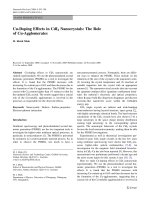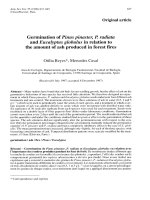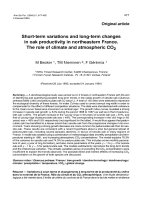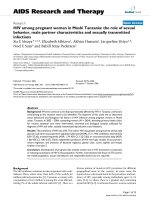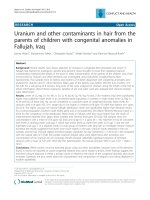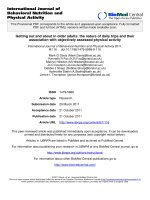depression and overgeneral memory in older adults the role of executive functioning
Bạn đang xem bản rút gọn của tài liệu. Xem và tải ngay bản đầy đủ của tài liệu tại đây (693.75 KB, 155 trang )
Glasgow Theses Service
Burns, Deirdre (2014) Depression and overgeneral memory in older
adults: the role of executive functioning. D Clin Psy thesis.
Copyright and moral rights for this thesis are retained by the author
A copy can be downloaded for personal non-commercial research or
study, without prior permission or charge
This thesis cannot be reproduced or quoted extensively from without first
obtaining permission in writing from the Author
The content must not be changed in any way or sold commercially in any
format or medium without the formal permission of the Author
When referring to this work, full bibliographic details including the
author, title, awarding institution and date of the thesis must be given
DClinPsy 2014 University of Glasgow
Volume I 1
Depression and Overgeneral Memory in Older Adults: The role of
Executive Functioning
And Clinical Research Portfolio
Volume I
(Volume II bound separately)
Deirdre Burns
(BSc Hons, MSc)
Mental Health and Wellbeing
University of Glasgow
1st Floor, Admin Building
Gartnavel Royal Hospital
1055 Great Western Road
Glasgow G12 0XH
September 2014
Submitted in partial fulfilment of the requirement for the degree of Doctorate in Clinical Psychology
(DClinPsy)
© Deirdre Burns 2014
DClinPsy 2014 University of Glasgow
Volume I 2
Acknowledgements
Firstly, my sincere thanks to all the people who gave their time to take part in this study.
Thank you to my supervisors, Professor Kate Davidson and Dr. Clive Ferenbach, for your
much appreciated support, guidance and time. Thank you to all the NHS staff who
helped in the recruitment stages of this project, with special thanks to the Psychology
Therapies for Older People Team in Lanarkshire. Thank you to my family and friends,
who have supported me in more ways than they know, especially my father. To Stephen,
for your patience, understanding and unwavering belief and support throughout these last
3 years. Finally, to my beautiful daughter Niamh for the gift of perspective and making
me laugh everyday.
DClinPsy 2014 University of Glasgow
Volume I 3
Declaration of Originality Form
This form
must
be completed and signed and submitted with all assignments.
Please complete the information below (using BLOCK CAPITALS).
Name DEIRDRE BURNS
Student Number 0207380
Course Name DOCTORATE IN CLINICAL PSYCHOLOGY
Assignment Number/Name CLINICAL RESEARCH PORTFOLIO
An extract from the University’s Statement on Plagiarism is provided overleaf. Please read
carefully THEN read and sign the declaration below.
I confirm that this assignment is my own work and that I have:
Read and understood the guidance on plagiarism in the Doctorate in Clinical
Psychology Programme Handbook, including the University of Glasgow Statement
on Plagiarism
X
Clearly referenced, in both the text and the bibliography or references,
all sources
used in the work
X
Fully referenced (including page numbers) and used inverted commas for
all text
quoted from books, journals, web etc. (Please check the section on referencing in
the ‘Guide to Writing Essays & Reports’ appendix of the Graduate School
Research Training Programme handbook.)
X
Provided the sources for all tables, figures, data etc. that are not my own work X
Not made use of the work of any other student(s) past or present without
acknowledgement. This includes any of my own work, that has been previously,
or concurrently, submitted for assessment, either at this or any other educational
institution, including school (see overleaf at 31.2)
X
Not sought or used the services of any professional agencies to produce this work X
In addition, I understand that any false claim in respect of this work will result in
disciplinary action in accordance with University regulations
X
DECLARATION:
I am aware of and understand the University’s policy on plagiarism and I certify that this
assignment is my own work, except where indicated by referencing, and that I have
followed the good academic practices noted above
Signature Date
DClinPsy 2014 University of Glasgow
Volume I 4
CONTENTS
VOLUME 1 PAGE
Chapter 1 - Systematic Review 5
“A Systematic Review of Executive Functioning in Depressed Older Adults”
Chapter 2 - Major Research Project 43
“Depression and Overgeneral Memory in Older Adults: The role of Executive
Functioning.”
Chapter 3 - Advanced Clinical Practice I Reflective Critical Account 80
(Abstract Only)
“Personal reflections on the challenges of multidisciplinary team working in
health care settings.”
Chapter 4 - Advanced Clinical Practice II Reflective Critical Account 82
(Abstract Only)
“When The Student Becomes The Teacher – reflections on the experience of
training others.”
Appendices 84
1. Appendix 1 Journal submission details 85
2. Appendices Systematic Review 101
Appendix 2.1 Data Extraction Sheet 102
Appendix 2.2 Quality Rating Scale 106
3. Appendices Major Research Project 110
Appendix 3.1 Participant information sheet 111
Appendix 3.2 Participant consent form 116
Appendix 3.3 Ethical Approval Letter I 119
Appendix 3.4 Ethical Approval Letter II 128
Appendix 3.5 Research and Development Approval Letter 132
Appendix 3.6 Major Research Project Proposal 136
DClinPsy 2014 University of Glasgow
Volume I 5
Chapter 1: Systematic Review
A Systematic Review of Executive Functioning in Depressed Older Adults
Deirdre Burns*
Written according to guidelines for submission
to the Journal of Clinical and Experimental Neuropsychology
(see Appendix 1)
*Address for correspondence:
Mental Health and Wellbeing
Academic Centre
Gartnavel Royal Hospital
1055 Great Western Road
Glasgow, G12 0XH
Tel: 0141 211 3927
Submitted in partial fulfillment of the requirement for the degree of Doctorate in Clinical
Psychology (DClinPsy)
DClinPsy 2014 University of Glasgow
Volume I 6
ABSTRACT
Background: There is evidence to suggest that, within an adult population, deficits in
executive functioning co-exist with depression. However, due to a lack of
comprehensive literature reviews it is currently unclear whether a similar link exists
between executive functioning deficits and depression within the older adult population.
Aims: This paper systematically reviews the current evidence regarding executive
functioning (EF) abilities and depression in adults aged over 65 years of age.
Methods: A systematic search of electronic databases was conducted against set
eligibility criteria. The reference lists of eligible papers were also manually searched. A
quality appraisal checklist was developed and applied to the included articles. Eight
articles met the eligibility criteria.
Results: Evidence was found for both the ‘shifting’ and ‘inhibition’ facets of EF (as
proposed by Miyake et al, 2000) being associated with depression in older adults.
However these findings were not unanimous across all studies in this review. The small
number of studies included in this review, differences in the quality of these studies and
differences in performance between specific neuropsychological tests could explain this
mixed picture. No studies investigated the ‘updating’ facet of executive functioning.
Phonemic verbal fluency and processing speed were both found not to differ between
depressed and non-depressed individuals.
Conclusions: Shifting was found to be related to depression in older adults, dependent
on type of neuropsychological test used. Indications point towards a link between
inhibition and depression however limited conclusions can be drawn due to the lack of
studies investigating this. Updating was not investigated by any study. Overall, this
review points to a lack of research within this area. Further research is needed to clarify
the relationships between EF and depression within older adult populations.
Methodological factors such as small samples, lack of power, and task impurity could
have impacted on the findings in these studies.
DClinPsy 2014 University of Glasgow
Volume I 7
Contents Page
1. Introduction 8
1.1. Definitions of Executive Functioning and Older Adult 10
2. Aims of the review 11
3. Methodology 12
3.1 Search Strategy 12
3.2 Inclusion/Exclusion criteria 13
3.3 Selection process 14
3.4 Quality Evaluation 15
4. Quality of Studies 16
4.1 Quality Rating Scale 17
4.1.1 Selection of sample 17
4.1.2 Assessment of Executive Functioning 18
4.1.3 Methodology and Design 19
4.1.4 Data Analysis 19
5. Results and Discussion 22
5.1 Study Characteristics 22
5.1.1 Age and Gender 22
5.1.2 Populations 22
5.1.3 Measurement, and severity of depression 22
5.1.4 Medication 23
5.2 Sample size and Effect Size 24
5.3 Executive Functioning 25
5.3.1 Shifting 25
5.3.1.1 Trail Making Test 26
5.3.1.2 Wisconsin Card Sort Test 27
5.3.1.3 Summary of Shifting 28
5.3.2 Inhibition 29
5.3.2.1 Stroop Test 29
5.3.2.2 Other neuropsychological tests 30
measuring inhibition
5.3.2.3 Summary of inhibition 30
5.3.3 Updating 31
5.4 Other cognitive abilities 31
5.4.1 Verbal Fluency 31
5.4.2 Processing Speed 32
6 Conclusions 33
7 Limitations 35
8 Future Directions 36
9 References 36
Figures and Tables
Figure 1 Flow diagram of selection process for papers included in 15
systematic review
Table 1. Quality ratings and description of strengths and weaknesses of the 20
studies reviewed.
Table 2. Main characteristics of studies reviewed. 24
Table 3. Summary of the findings of studies reviewed: Executive 28
functioning tests/Processing speed and their relationship with depression
DClinPsy 2014 University of Glasgow
Volume I 8
1. INTRODUCTION
Numerous studies have investigated the relationship between depression and cognitive
impairment. Executive Dysfunction (deficits in the cognitive domain of Executive
Functioning) is one such cognitive impairment. Executive Functioning (EF) has been
defined in many ways but the common theme is that it encompasses the higher level
cognitive processes that control and regulate lower level cognitive processes, and
purposefully guide goal-orientated behaviour. EF abilities such as decision making,
planning and prioritisation allow individuals to respond flexibly to the world around
them, especially in novel situations. Impairment of EF can therefore have huge
implications for abilities of daily living.
EF deficits, or Executive Dysfunction has been widely researched within the adult
population and there is evidence to suggest that EF deficits co-exist with depression
(Elderkin-Thompson, Mintz, Haroon, Lavretsky and Kumar, 2007, see Synder, 2013 for a
review). Research investigating this link in older adult populations has found that
depressed older people have greater executive functioning deficits than non-depressed
older adults (Butters, et al., 2004; Nebes et al., 2000; Rapp et al., 2005), and greater EF
deficits than depressed younger adults (Fossati, Coyette, Ergis and Allilaire, 2002).
However findings have been somewhat mixed with some studies failing to replicate
findings of previous research (e.g. Mackin and Arean, 2009, found no EF deficits in
depressed older adults). Compared to studies involving adult populations; there are
notably fewer studies investigating the link between EF deficits and depression in older
adults.
DClinPsy 2014 University of Glasgow
Volume I 9
There are many literature reviews of cognition and depression indicating that depressed
individuals have a multitude of cognitive deficits that are not present in the non-
depressed population. (Adult: Ottowitz, Dougherty and Savage, 2002; Hammar and
Ardal, 2009; Lee, Hermens, Porter and Redoblado-Hodge, 2012 – for a meta-analysis,
and older adult : Thomas and O’Brien, 2008; Steffens and Potter, 2008). However, few of
these reviews have been systematic reviews or had a specific EF focus. An exception is
the work of Snyder (2013) which involved a comprehensive meta-analysis and review of
EF and Major Depressive Disorder (MDD) covering over 100 research studies. It found
that MDD is reliably associated with impaired performance on neuropsychological
measures of EF (effect sizes ranging from d = 0.32 to 0.97). Usefully, Snyder (2013)
used the Miyake, Friedman, Emerson and Howerter (2000) model (a commonly used
model of EF) that divides EF into three distinct sub-categories (Shifting, Inhibition and
Updating – see section 2 for definitions). Although linked, these sub-categories can be
thought of and (crucially) measured separately. In Snyder’s (2013) review the mean age
of participants in the included studies was 46 years. Few studies included participants
who would be considered older adults in a clinical setting (i.e. over 65 years of age).
The link between EF and depression in older adults is clinically relevant as it has been
found that those individuals with depression with executive dysfunction have greater
functional disability (Alexopoulos et al., 1997; Butters et al., 2004) and poorer treatment
response to antidepressants (Dunkin et al., 2000; Baldwin et al., 2005).
DClinPsy 2014 University of Glasgow
Volume I 10
1.1 Definitions of EF and Older Adult
An inherent difficulty in all EF research has been how exactly to define EF and
consequently how to measure it. EF, as a higher-arching set of cognitive abilities, is
difficult to extract from other cognitive processes (e.g. memory), in order to measure
‘pure’ EF. Researchers often use different neuropsychological tasks to measure aspects
of EF. This makes comparison between studies difficult.
Determining who constitutes an ‘older adult’ also requires consideration. Age-related
cognitive decline is highly prevalent within non-clinical populations, as is damage to the
frontostriatal circuitry in older adults, an area thought to be responsible - at least in part -
for EF (Kramer, Humphrey, Larish, Logan and Strayer, 1994; Turner and Spreng, 2012).
The age range of study participants in studies that investigate EF and depression in older
adults is very wide. The term ‘older adult’ has been applied to individuals aged from mid
50’s (Sairs, Welsh-Bohmer, Wagner and Steffens, 2006; Baudic, Tzortzis, Barba and
Traykov, 2004) to those over 70 years of age (Liu et al, 2012 ; Eggermont, Milberg,
Lipsitz, Scherder and Leveille, 2009
). Given what is known about how EF deficits
increase with age (Turner and Spreng, 2012), it is difficult to draw any firm conclusions
from the literature about the relationship between executive functioning and depression
specifically in older adults without proper consideration of age ranges. Although many
studies attempt to control for age (including age as a covariate), it is still unclear how
representative their findings are of clients attending for mental health treatment in UK
older adult services who often only see clients aged 65 years and upwards.
DClinPsy 2014 University of Glasgow
Volume I 11
2. AIMS OF THE REVIEW
This systematic review aims to collate and analyse the research that investigates EF and
depression specifically in older people. It will be the first review in this area to critically
assess the quality of the evidence in available literature alongside a summary of study
findings.
Following on from Snyder (2013), the available literature will be discussed in terms of
Miyake’s et al. (2000) model which separates EF into three distinct subcategories:
- Inhibition - the ability to deliberately inhibit dominant, automatic or pre-potent
responses when necessary.
- Shifting – the ability to shift back and forth between multiple tasks, operations or
mental sets.
- Updating – the updating and monitoring of working memory representations.
The standard age range for Older People’s health services (including mental health) in
Scotland/UK is 65 years and over. Therefore a participant age minimum age limit of 65
years will be applied to allow conclusions to be of greater clinical significance.
The main aim of this review is to summarize the evidence and critique the literature that
investigates EF in depressed older adults. This review attempts to answer the following
questions:
DClinPsy 2014 University of Glasgow
Volume I 12
1. Of what quality are the studies that comprise the available literature on
depression and EF in older adults?
2. Do depressed older adults exhibit more executive functioning deficits than non-
depressed older adults? If so, are the deficits more pronounced in some sub-
categories of EF than others?
3. METHODOLOGY
The methods used for the undertaking and reporting of this systematic review are based
on guidance outlined by the Centre for Reviews and Dissemination (2009) and the
PRISMA statement (Moher, Liberati, Tetzlaff and Altman, 2009; Liberati et al., 2009)
3.1 Search Strategy
A systematic search of electronic databases was conducted. The following databases
were searched to identify studies: Medline and Embase (via OVID online); PsychInfo
(via EBSCOhost); Web of Science (via Web of Knowledge) and the Psychology &
Behavioral Sciences Collection.
The following search terms were used, both as key words and as subject headings,
creating two search strings (using the Boolean operator ‘OR’ to combine searches within
strings).
DClinPsy 2014 University of Glasgow
Volume I 13
Executive function* ‘OR’ Cognitive Impair*
Depressive Disorder ‘OR’ Major Depressi* ‘OR’ MDD (Initially the search term
Depress* was included in this search string. However due to the volume of returned articles
exceeding 8’000 it was decided to remove this term due to time and resource limitations)
The two search strings were then combined using the Boolean operator ‘AND’ to
produce the final output. Searches were limited to those published in English with
human subjects. A minimum age limit of 65 years was applied in those databases where
this was available. No date limitation was applied. All database searches were carried
out on 21
st
January 2014. Hand searches were also carried out on reference lists of
selected papers and also on a recent relevant meta-analysis (Synder, 2013).
The title and abstract of each paper identified from the search was screened for suitability
according to inclusion and exclusion criteria with full text papers being sought for
suitable articles. Full text was also obtained when suitability could not be determined
from the review of the title and abstract alone.
3.2 Inclusion and Exclusion criteria
Inclusion criteria
Participants aged 65 and above with Depression
Control group aged 65 and above without Depression
Outcome measures include at least one recognised test of executive function
Exclusion criteria
Diagnosed Mild Cognitive Impairment, Dementia or use of cognitive enhancer
medication
DClinPsy 2014 University of Glasgow
Volume I 14
Participants aged under 65 years of age
Participants with remitted Depression
Participants included those who have suffered from head injury, Stroke,
Parkinson’s Disease.
Single case studies
No clearly defined control group
Where eligibility for inclusion remained unclear, another researcher also reviewed the
full article, and agreement was reached through discussion.
3.3 Selection process
Electronic searches returned 2023 results, which was reduced to 1050 once duplicate
articles were removed. These 1050 were examined, along with the 114 identified in the
Synder review (2013), according to the inclusion and exclusion criteria, giving a total of
1164. Of this total, 1067 articles were rejected on the basis of title and abstract alone.
The remaining 97 had full text obtained after which 8 of these met criteria for inclusion.
These articles were hand searched for potential eligible articles and 16 full text articles
were sought, of which none were eligible for inclusion. Therefore, the final number of
studies found to be eligible for inclusion in this review was 8. The selection process is
illustrated in Figure 1.
DClinPsy 2014 University of Glasgow
Volume I 15
Figure 1. Flow diagram of selection process for papers included in systematic review
3.4 Quality evaluation
As per the PRISMA Statement (Moher et al., 2009; Liberati et al., 2009), quality
evaluation criteria were utilised to evaluate the methodological quality of studies in this
review. A quality appraisal checklist that assessed key methodological components (see
Appendix 2.2) was developed specifically for this review. Its content was based on
Electronic Search
2023
After Duplicates
removed
1050
Rejected on basis of title and
abstract
959
Accepted on basis of title
and abstract
91
Rejected on basis of
full text
89
Accepted on basis of full
text
8
Accepted on basis
of title and abstract
21
Full text obtained
97
Duplicates removed
15
Hand search of Synder (2012)
(Total no. of articles = 114)
Rejected on
basis of title
and abstract
93
DClinPsy 2014 University of Glasgow
Volume I 16
existing frameworks, including the Clinical Trials Assessment Measure (CTAM; Tarrier
& Wykes, 2004). The checklist included information on the methodology and design of
the study; the selection of participants; the assessment of EF and data analysis.
As recommended by the Centre for Reviews and Dissemination (2009) the checklist was
piloted on a random selection of the articles (n=3) and adjustments made accordingly. An
independent rater reviewed the quality rating of 75% of the included papers. Inter-rater
agreement was high with raters agreeing on 90% of scoring items. This increased to 96%
following discussion. The final quality appraisal checklist included 24 items, yielding a
total score of 40. Scores were converted to percentages and categorised to allow for
comparison, as follows: Poor Quality (>50%); Acceptable Quality (51-60%); Good
Quality (61-70%); Excellent Quality (71-80%); and Exceptional Quality (81+%).
4. QUALITY OF STUDIES
(Aim 1)
The quality of the studies (as measured by the specially devised Quality Rating Scale –
see Appendix 2.2) included in this review ranged from ‘Excellent’ to ‘Acceptable.’ Three
studies were classified as of ‘Acceptable’ quality (Rainer et al, 2006, Mackin et al, 2009,
and Kramer-Ginsberg et al, 1999), with a further three studies classified as of ‘Good’
quality (Reppermund et al, 2011; Ganguli et al, 2006; Schoepflin-Sanders et al, 2006),
see Table 1. Two studies were assessed to be of excellent quality (Liu et al, 2012;
Richard-Devantay, 2012).
DClinPsy 2014 University of Glasgow
Volume I 17
Table 1. also highlights the strengths and weaknesses of each study as determined by the
four key areas assessed by the Quality Rating Scale.
4.1 Quality Rating Scale
4.1.1 Selection of Sample
Most studies recruited their study sample by convenience sampling which introduces an
element of bias into the study. However, of note, two studies used a geographic method
of sampling in selecting their participants (Rainer et al., 2006; Reppermund et al., 2011),
which removes the selection bias of convience sampling. Studies who scored highly in
this area utilised clinician rating scales for assessment of depression (e.g. Schoepflin-
Sanders et al., 2006) rather than rely on self report methods (Ganguli et al., 2006). All
but one study (Schoepflin-Sanders et al., 2006) were clear on their inclusion and
exclusion criteria for their study, allowing the reader to replicate the study and understand
the limits of generalisation of the findings.
Studies with the lowest scores in this area did not control for comorbidity of other
psychiatric disorders, for example anxiety (Ganguli et al., 2006; Mackin et al., 2009;
Schoepflin-Sanders et al., 2006). In addition both Mackin et al. (2009) and Schoepflin-
Sanders et al. (2006) did not report whether or not their participant sample was taking any
psychiatric medication. By not controlling for comorbidity and medication use, any
findings could be the results of these confounding variables and not a true interaction of
depression and EF.
DClinPsy 2014 University of Glasgow
Volume I 18
4.1.2 Assessment of Executive Functioning
All studies used appropriately reliable and validated EF tests. Studies that scored highest
in this area (Richard-Devantay et al., 2012; Ganguli et al., 2006) ensured that the
individuals administering and scoring the neuropsychological tests were blinded to which
group a participant belonged to (ie. depressed or control groups). This helps to eliminate
clinician bias. Studies (for example, Reppermund et al., 2011; Liu et al., 2012) also
scored well if they included an appropriate neuropsychological control task (such as Trail
A – measure of psychomotor speed). Such tasks help to reduce a known confounding
variable in neuropsychological testing (for further detail see section 5.4.2).
The majority of the studies used only one neuropsychological task to measure a certain
aspect of EF. For example, when investigating ‘shifting’ ability, only Trail B was
administered to the participants (as in Reppermund et al, 2011; Ganguli et al, 2006;
Schoepflin-Sanders et al, 2006; Rainer et al, 2006). This can lead to task impurity
whereby true associations can be missed by only using one neuropsychological task.
This is due to tasks measuring EF inherently operating on other cognitive processes (e.g.
Trail B, although designed to measure switching between mental sets, also relies on
visual processing). Therefore deficits shown on one task might not necessarily be due to
an EF deficit, but may instead be due to a deficit in another cognitive process necessary
to carry out that task. If multiple tests tapping into the same EF ability are used then this
can help address this problem. In this review, only three studies carried out multiple
tasks per EF ability: Richard-Devantay (2012) for inhibition and Liu et al (2012) and
Mackin et al (2009) for switching.
DClinPsy 2014 University of Glasgow
Volume I 19
4.1.3 Methodology and Design
Studies who scored well in this area (Ganguli et al., 2006; Liu et al., 2012) utilised a non-
clinical comparison group (healthy control group). Another strength of some of the
studies was considering key demographics and either matching the groups by these (e.g.
gender, age etc) or making allowances for significant demographic differences between
the groups in their analysis (Rainer et al., 2006; Liu et al., 2012). Of note, a few studies
(Mackin et al., 2009; Rainer et al., 2006; Reppermund et al., 2011) did not control for
general cognitive functioning in their study, for example by administering the Mini
Mental State Exam (Folstein, Folstein, and McHugh, 1975) or the Addenbrookes
Cognitive Examination (Mioshi, Dawson, Mitchell, Arnold, and Hodges, 2006). General
cognitive functioning is impaired in Mild Cognitive Impairment and diseases such as
dementia. Without assessing for this there is the possibility that deficits in EF could be
representative of a wider cognitive deficit and not necessarily of depression.
4.1.4 Data Analysis
All studies carried out appropriate statistical analysis of their data, however all but one
study (Ganguli et al., 2006) failed to report data on those potential participants who
declined to participate in the study, or those participants who dropped out of the study
prior to completion. It is therefore unclear if the findings in these studies are
representative of the sample as a whole. In addition those studies who scored lower in
this area reported their results poorly, in terms of reporting confidence intervals, p-values
etc. (Reppermund et al., 2011; Mackin et al., 2009).
DClinPsy 2014 University of Glasgow
Volume I 20
Lui et al . (2012) Richard-Devantay et al. (2012) Ganguli et al. (2006) Schoepflin-Sanders et al. (2006)
Total Quality Score
Excellent – 73% Excellent – 70% Good - 65% Good – 65%
Selection of Sample
(max 15)
11/15
Strengths: clear inclusion/exclusion
criteria, reported medication use,
comorbididity controlled for
Weaknesses: no data on non-participants
11/15
Strengths: clear inclusion/exclusion criteria, , clinician
assessed for depression.
Weaknesses: no data on non-participants
8/15
Strengths: Clear inclusion/exclusion criteria
Weaknesses: No data on non-participants,
comorbidity not controlled for, no report of
depression severity
9/15
Strengths: Clear inclusion/exclusion criteria,
clinician assess for depression
Weaknesses: No description of recruitment
method used, comorbidity not controlled for,
no data on medication usage.
Assessment of EF
(max 9)
6/9
Strengths: appropriate control task used,
good description of EF tests,
Weaknesses: single NP measures used
per EF, no blinding of NP assessors
7/9
Strengths: Multiple NP measure used per EF, appropriate
control task used, NP assessors blinded to group
Weaknesses: No description of EF tests
6/9
Strengths: Assessors ‘blinded’ re depression status,
appropriate control task used
Weaknesses: single NP measures used per EF
6/9
Strengths: appropriate control task used, clear
description of EF tests.
Weaknesses: no blinding of NP assessors,
single NP measures used per EF ability.
Methodology and
Design
(max 11)
9/11
Strengths: Non-clinical comparison
group, matching of depressed and
control group by demographics,
controlled for GCF
Weaknesses: Power not reported
7/11
Strengths: Non-clinical comparison group, controlled for
GCF.
Weaknesses: Power not reported
8/11
Strengths: Non-clinical comparison group
Weaknesses: Power not reported
8/11
Strengths: Non-clinical comparison group,
controlled for GCF.
Weaknesses: Power not reported.
Data Analysis
(max 5)
3/5
Strengths: Appropriate analysis
Weaknesses: No data on dropouts
3/5
Strengths: Appropriate analysis
Weaknesses: No data on dropouts
4/5
Strengths: Appropriate analysis and data on dropouts
provided.
3/5
Strengths: Appropriate analysis
Weaknesses: No data on dropouts.
Table 1. Quality ratings and description of strengths and weaknesses of the studies reviewed.
DClinPsy 2014 University of Glasgow
Volume I 21
Reppermund et al (2011) Mackin et al. (2009) Kramer-Ginsberg et al. (1999) Rainer et al. (2006)
Total Quality Score
Good – 63% Acceptable – 58% Acceptable - 55% Acceptable – 53%
Selection of Sample
(max 15)
11/15
Strengths: Clear inclusion/exclusion
criteria, use of geographic sampling.
Weaknesses: No data on non-
participants, no data on medication use
7/15
Strengths: Clear inclusion/exclusion criteria,
clinician assess for depression
Weaknesses: No description of recruitment
method used, comorbitidy not controlled
for, no data on medication usage.
10/15
Strengths: Clear inclusion/exclusion criteria, clinician
assessed for depression
Weaknesses: No data on non-participants, no data on
medication use
11/15
Strengths: Clear inclusion/exclusion criteria, use of
geographic sampling, clinician assessed for depression.
Weaknesses: No data on non-participants,
comorbidity not controlled for.
Assessment of EF
(max 9)
6/9
Strengths: multiple NP measures used
per EF, control task used.
Weaknesses: no blinding of assessors of
NP tests, poor description of EF tests.
8/9
Strengths: multiple NP measures used per EF,
appropriate control task used, clear description
of EF tests.
Weaknesses: no blinding of NP assessors
2/9
Weaknesses: single NP measures used per EF, no
blinding of assessors of NP tests, no control task
used.
1/9
Weaknesses: Assessors of NP not ‘blinded’ re depression
status, no appropriate control task used, single
NP measures used per EF, no description of EF tests.
Methodology and
Design
(max 11)
6/11
Strengths: Non-clinical comparison
group,
Weaknesses: Power not reported, did not
control for GCF
6/11
Strengths: matching of depressed and control
group by demographics
Weaknesses: Power not reported, did not
control for GCF
7/11
Strengths: Non-clinical comparison group, matching
of depressed and control group by demographics
Weaknesses: Power not reported, did not control for
GCF
6/11
Strengths: matching of depressed and control group by
demographics.
Weaknesses: Power not reporte, did not control of GCF
Data Analysis
(max 5)
2/5
Strengths: Appropriate analysis
Weaknesses: No data on dropouts, poor
reporting of CI, P-values etc.
2/5
Strengths: Appropriate analysis
Weaknesses: No data on dropouts, poor
reporting of CI, P-values etc.
3/5
Strengths: Appropriate analysis
Weaknesses: No data on dropouts.
3/5
Strengths: Appropriate analysis
Weaknesses: no data on dropouts provided.
Table 1 (continued). Quality ratings and description of strengths and weaknesses of the studies
reviewed
.
(EF – Executive Functioning; CI – Confidence intervals; GCF – Global cognitive functioning; NP – neuropsychological)
DClinPsy 2014 University of Glasgow
Volume I 22
5. RESULTS AND DISCUSSION
5.1 Study characteristics (see Table 2)
5.1.1 Age and Gender
The total number of participants included in the studies was 3190, which comprised 551 depressed
and 2639 control participants The mean age of all the participants in the studies was 75.8 years of
age. The mean age of the depressed participants was 76.4 and ranged from 81.2 years (Liu et al,
2012) to 74.0 years (Schoepflin-Sanders, Lyness, Eberly, King and Caine, 2006). The mean age of
the control participants was 75.2 and ranged from 81.4 years (Liu et al, 2012) to 72.8 years (Kramer-
Ginsberg et al, 1999). Information on the gender of participants was provided by all studies. With
the exception of one study which included only men (Liu et al, 2012), all studies included more
women than men, with the percentage of women ranging from 54.6% (Ganguli, Du, Dodge, Ratcliff,
and Chang, 2006) to 67% (Rainer et al, 2006).
5.1.2 Populations
Three studies recruited participants from mental health care settings (community, Kramer-Ginsberg et
al, 1999; Mackin et al, 2009, and inpatient Richard-Devantay et al, 2012). One study recruited from
primary care (Schoepflin-Sanders et al, 2006), and one study recruited from a supported living
accommodation facility (Liu et al, 2012). The remaining three recruited from community populations
(Reppermund et al, 2011; Ganguli et al, 2006; Rainer et al, 2006).
5.1.3 Measurement and severity of depression
Four studies (Kramer-Ginsberg et al, 1999; Schoepflin-Sanders et al, 2006; Mackin et al, 2009;
Richard-Devantay et al, 2012) utilized both clinician and self report measures of depression. Three
DClinPsy 2014 University of Glasgow
Volume I 23
studies measured depression by self report measures (Liu et al, 2012; Reppermund et al, 2011;
Ganguli et al, 2006), and one study assessed depression by clinician assessment alone (Rainer et al,
2006). The most common method used by clinicians to determine the presence or absence of
depression was to use the Diagnostic and Statistical Manual, 4
th
Edition (DSM-IV – four studies),
followed by the Structured Clinical Interview for DSM-III-R (SCID, Spitzer, 1992 - two studies).
The most common self report measure used was the Hamilton Depression Rating Scale (HDRS,
Williams, 1988, - five studies) followed by the Geriatric Depression Scale (GDS, Sheikh and
Yesavage, 1986 - two studies).
Severity of depression was reported in seven studies. Two studies reported the number of
participants with Major Depressive Disorder over Minor depressive disorder (Schoepflin-Sanders et
al, 2006 – 44%; Rainer et al, 2006 – 45%). One study had inclusion criteria that allowed only those
with MDD to participate (Mackin et al, 2009). Of the five studies that used the HDRS, the mean
score was 24.4 indicating severity in the ‘very severe’ range. Only one of the two studies that used
the GDS reported scores for severity, Liu et al, 2012 reported an average GDS score of 7.5, indicating
symptoms within the ‘normal’ range. History of, and duration of depression were reported in only
one study (Richard-Devantay et al, 2012), where 50% of depressed participants had a psychiatric
history of depressive disorder and 38% of participants had two or more previous depressive episodes.
5.1.4 Medication
Medication use was reported in three studies (Reppermund et al, 2011; Ganguli et al, 2006; Rainer et
al, 2006) where the percentage of depressed participants using antidepressant or benzodiazepine
medication was reported as 35%, 22% and 35% respectively. Mackin et al (2009) excluded those that
were taking medication from their study. In contrast, depressed participants in Liu et al (2012) and
Richard-Devantay et al (2012) were all given some form of medication (antidepressants and/or
benzodiazepines) on entry to the study.
DClinPsy 2014 University of Glasgow
Volume I 24
Table 2. Main characteristics of studies reviewed.
(N/A – data not available; SD – Standard deviation; D – Depressed group; C – Control group; GDS – Geriatric Depression Scale; DSM-IV – Diagnostic and Statistical
Manual -IV; Ham-D – Hamilton Depression Rating Scale; SCID – Structured Clinical Interview for Depression; mCES-D – modified Centre for Epidemiological Studies –
Depression Scale)
5.2 Sample Size and Effect Size
Of note, no study included in this review reported effect sizes. However, for those studies where the
data was available (i.e. mean and standard deviation of both depressed and non-depressed groups),
Study Population/ recruitment Gender
(female)
No of participants Mean Age (SD) Depression
measure
Medication
use
D C D C
Liu et al. (2012) Executive
functions in elderly men
Chinese male war veterans
aged 75 years old and
upwards living in supported
accommodation
0% 133 45 81.2
(3.98)
81.4
(3.89)
GDS 100%
Reppermund et al. (2011) The
relationships of current and past
depressive symptoms with cognitive
impairment and activities of daily
living in elderly population
Community dwelling older
people aged 70-90 years of
age in Australia
57% 49 751 N/A N/A mCES-D 35%
Ganguli et al. (2006) Depressive
symptoms and cognitive decline in
late life: a prospective
epidemiological study.
Community dwelling older
people over 65 years of age
American voters and
volunteers
55% 128 1137 75.8
(5.5)
74.5
(5.1)
Ham-D
SCID
22 %
Kramer-Ginsberg et al. (1999)
Neuropsychological functioning and
MRI signal hyperintensities in
geriatric depression
Patients at geriatric
psychiatry service
(inpatient, and outpatients)
and volunteers from
community
62% 41 38 74.0
(6.2)
72.8
(6.4)
Ham-D
SCID
N/A
Schoepflin-Sanders et al. (2006)
Cerebrovascular risk factors,
executive dysfunction and
depression in older primary care
patients.
American 65 years of age
and over presenting for care
at their local primary care
clinic
60% 24 394 74.0
(6.2)
74.7
(6.6)
Ham-D
DSM-IV
0%
Mackin et al. (2009) Impaired
financial capacity in late life
depression is associated with
cognitive performance on measures
of executive functioning and
attention.
American adults over the
age of 65 recruited via
media and financially
remunerated for
participation.
66% 65 32 N/A N/A Ham-D
DSM-IV
0%
Richard-Devantay et al. (2012)
Deficits of cognitive inhibition in
depressed elderly: a neurocognitive
marker of suicidal risk
French adults over the age
of 65 – psychiatric
inpatients and a control
group of community
dwellers
63% 40 20 76.5
(7.0)
75.2
(3.4)
DSM-IV 100%
Rainer et al. (2006) Data from the
VITA study do not support concept
of vascular depression
Austrian community
dwelling adult volunteers
aged between 75-76 years
of age.
67% 51 204 N/A N/A DSM-IV 35%



